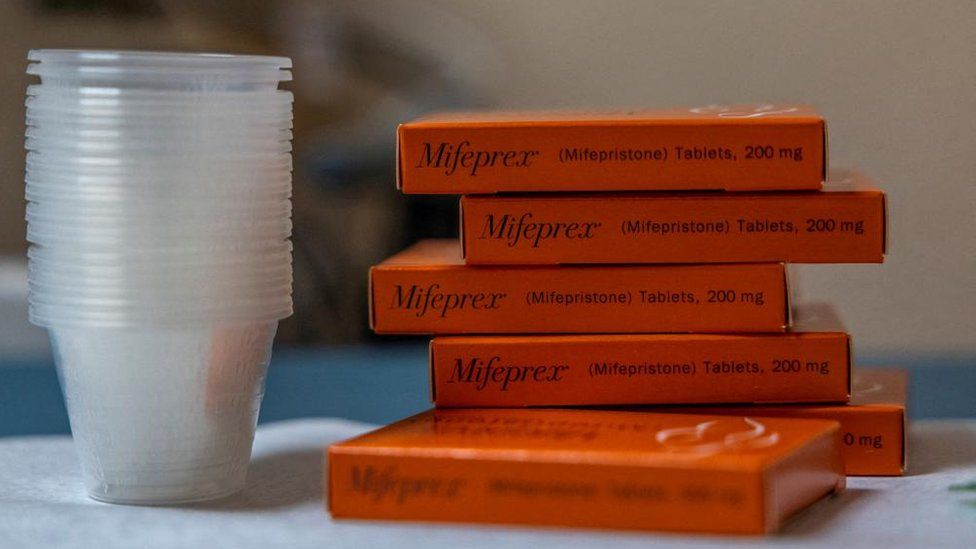ARTICLE AD BOX
 Image source, Reuters
Image source, Reuters
A ruling that would restrict access to an abortion pill across the US will soon take effect unless the conservative-dominated Supreme Court intervenes.
The top court last year struck down the national right to abortion, leading over a dozen Republican-aligned states to pass outright bans.
The latest action by anti-abortion groups now seeks to limit access to the abortion pill mifepristone.
The pill is used in more than half of abortions in the US.
It was first approved by the Federal and Drug Administration (FDA) more than two decades ago.
On Wednesday, the Supreme Court is set to decide the future of the pill's access in the US. Here is how we got here:
What is the Supreme Court ruling about?
The case now being considered by the top court arrived there after a federal judge in Texas ruled the FDA had not properly considered the drug's health effects when the agency approved it in 2000.
Minutes later, a federal judge in Washington state issued an opposing ruling, ordering the FDA to make no change to the drug's availability and preserving access to mifepristone in 17 US states.
The Texas ruling then went to the New Orleans-based 5th Circuit Court of Appeals, which ordered restrictions to accessing mifepristone, but did not outright suspend its FDA approval it as the Texas judge had ordered.
The US justice department and Danco Laboratories, which manufactures the drug, then called on the Supreme Court to intervene, asking it to reverse the ban and restrictions on the pill.
On Friday, US Supreme Court Justice Samuel Alito, who oversees emergency matters for 5th Circuit, ordered a temporary block on the restrictions as the court considers the drug's future.
Image source, Getty Images
Could access to abortion pills change?
Access to the abortion pill mifepristone across the US will hinge on what the Supreme Court decides to do.
If it sides with the 5th Circuit Court of Appeals or issues no ruling by the end of Wednesday, mifepristone will remain available but conditions on its access will be imposed immediately.
These conditions include requiring the drug be taken in the presence of a physician, that patients cannot receive the pill by post, and that the window for use of the pill shortens from up to 10 weeks of pregnancy to seven.
What might this all mean for other drugs?
Critics say that by overriding the FDA's approval, the court in Texas has usurped the federal health agency's remit to regulate food, medicine, and medical devices.
The Food, Drug, and Cosmetic Act of 1938 gives the FDA the authority to determine whether drugs are safe and effective, and typically, courts have deferred to the agency when it comes to scientific and medical decision-making.
I Glenn Cohen, a Harvard Law School professor, told the BBC that the pharmaceutical industry could be wary of more legal challenges, particularly to treatments that have become political flashpoints in the US, like transgender health care and Covid-19 vaccines.
"It's possible in any space, but … it's going to trickle down in some ways and play out to be the worst for drugs that are needed sometimes by discrete and insular minorities," Mr Cohen said.
What happens next?
Ahead of Wednesday, the Alliance Defending Freedom, a conservative Christian legal advocacy group that filed the initial lawsuit against the FDA, submitted a brief to the Supreme Court asking it to let the restrictions on mifepristone go into effect.
Their ask has been supported by 147 Republican lawmakers, who submitted their own brief to the court, calling the removal of conditions on access to the drug "a dangerous game with the health and safety of women and girls."
On the opposing side, a group of 253 Democratic lawmakers also weighed in, asking the Supreme Court to pause the original Texas ruling and leave mifepristone on the market as the case makes its way through the courts.
The Democrats argued the Texas ruling would restrict access to abortion nationwide.
Both briefs indicate that abortion remains a politicised debate in the US. All eyes will now be on the Supreme Court to see what it decides.
Watch: Abortion pills explained in 60 seconds

 1 year ago
18
1 year ago
18








 English (US)
English (US)